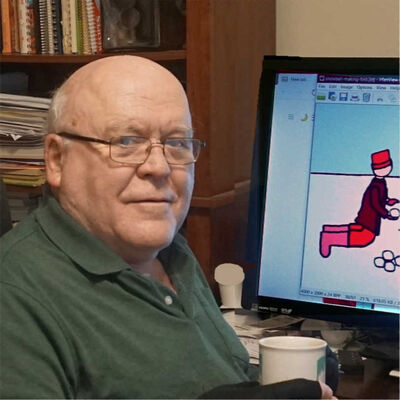Infrared processing
Feb 11, 2023 13:04:09 #
Looking for some acquired wisdom from fellow Hoggers...recently had a Nikon D600 converted to IR camera...have just starting taking images...have watched several youtube presentations on how to process images...any insights about best way to go from "raw" to final processing of IR images...much appreciated...
Feb 11, 2023 13:21:39 #
Feb 11, 2023 13:22:24 #
Feb 11, 2023 14:09:56 #
Feb 11, 2023 15:08:28 #
Phil Martin wrote:
Shoot JPEGs in B&W. Very little processing required!
Great insight...thanks very much...
Feb 12, 2023 06:34:11 #
zacksoccer had his Nikon converted to IR camera... but did not say if it was full spectra or tight into the Near IR with an internal filter of 720 nm or higher. My conversion philosophy is full spectra with a filter added at the far end of the lens. Impure IR is intriguing.
https://kolarivision.com/choosing-an-infrared-filter/
If indeed it is a Pure-IR, then processing with Topaz B&W2 will allow flavoring the image in many ways. I use Topaz Clarity to adjust levels of contrast. SOOC with out modification is simply B&W and soon becomes boring. The decision to conversion to IR is in its self a statement that creativity, away from standard color, is desired. Go for it Zack
https://kolarivision.com/choosing-an-infrared-filter/
If indeed it is a Pure-IR, then processing with Topaz B&W2 will allow flavoring the image in many ways. I use Topaz Clarity to adjust levels of contrast. SOOC with out modification is simply B&W and soon becomes boring. The decision to conversion to IR is in its self a statement that creativity, away from standard color, is desired. Go for it Zack

Feb 12, 2023 09:56:05 #
There is tremendous leeway in processing IR.
https://photographylife.com/how-to-process-infrared-photographs
http://photography.tutsplus.com/tutorials/an-in-depth-guide-to-infrared-photography-processing--photo-9540
http://digital-photography-school.com/5-creative-ways-to-process-infrared-photographs-in-photoshop/
https://www.youtube.com/watch?v=fOmq6VwvPY8
http://infrared-photography.freeforums.net/
http://www.lifepixel.com/
http://www.kolarivision.com/
http://lightroom-blog.com/2015/05/26/creating-false-color-infrared-in-lightroom/
https://photographylife.com/how-to-process-infrared-photographs
http://photography.tutsplus.com/tutorials/an-in-depth-guide-to-infrared-photography-processing--photo-9540
http://digital-photography-school.com/5-creative-ways-to-process-infrared-photographs-in-photoshop/
https://www.youtube.com/watch?v=fOmq6VwvPY8
http://infrared-photography.freeforums.net/
http://www.lifepixel.com/
http://www.kolarivision.com/
http://lightroom-blog.com/2015/05/26/creating-false-color-infrared-in-lightroom/
Feb 12, 2023 12:10:25 #
Phil Martin wrote:
Shoot JPEGs in B&W. Very little processing required!
Shoot RAW if you want the best B&W results.
Feb 12, 2023 18:30:47 #
dpullum wrote:
zacksoccer had his Nikon converted to IR camera...... (show quote)
I have one question. On these converted rigs are the sensors no longer set up for color. I would want color so that I can tell the temperature range of what I am looking at and not just the artistic creativity. But that is probably the physicist/chemist in me. --Richard
Feb 12, 2023 19:02:11 #
Feb 12, 2023 19:11:38 #
zacksoccer wrote:
yes...color rangrs are available...https://kolarivision.com/choosing-an-infrared-filter/
And provided the camera is done as full spectrum, you can add an UV-IR external filter and revert back to a normal, visible light only, camera.
Or, an alternate UV-IR filter that extends a little farther beyond red to capture the hydrogen alpha wavelength to emulate the astro mods that can be purchased from some camera manufactures.
I have both filters.
Feb 12, 2023 19:24:01 #
zacksoccer wrote:
Looking for some acquired wisdom from fellow Hoggers...recently had a Nikon D600 converted to IR camera...have just starting taking images...have watched several youtube presentations on how to process images...any insights about best way to go from "raw" to final processing of IR images...much appreciated...
1st you will find lots of how to’s on YouTube. 2nd your conversion company will give you their secret sauce. For me of late I skip channel swapping and use ACR masking to adjust tones to my eye then convert to B&W in Silver Efex Pro and finish in PS…just my way…your mileage may vary
Feb 15, 2023 13:33:21 #
Rob Shea has a lot of good info on IR photography.
And some great actions...
https://www.robsheaphotography.com/
And some great actions...
https://www.robsheaphotography.com/
Feb 15, 2023 13:39:48 #
Feb 15, 2023 23:03:23 #
JimH123 wrote:
Shoot RAW if you want the best B&W results.
Perhaps I should mention why RAW is the best way to go with IR:
1. If you shoot IR pseudo colors, there is the need to shift the White Balance. With JPEGs, you have to set a custom White Balance to use. And with JPEG, during processing, you may need to use a different White Balance. With JPEG, White Balance is baked into the image and there are limits to how far you can shift it. With RAW, there are no White Balance restrictions, especially if you add the color LUTs offered for free at Rob Shea's web site.
2. With B&W, the beauty of B&W comes from the gray scale tonality of the image. I find starting with a RAW where I can experiment with different White Balance places has a major impact on how the converted to B&W image will look. And I like to use a 590nm or 630nm IR filter to make sure that I have some visible color to work with since the visible light adds to the gray scale beauty of the image. On the other hand, an 850nm filter has no visible light to work with, and I find the end result somewhat harsh looking with less gray scale.
If you want to reply, then register here. Registration is free and your account is created instantly, so you can post right away.





